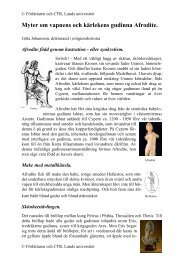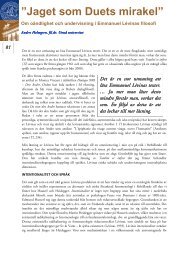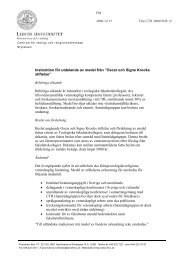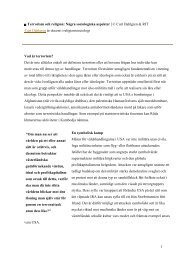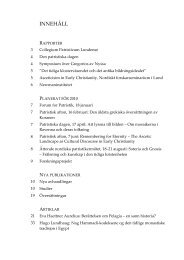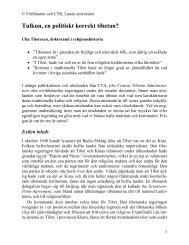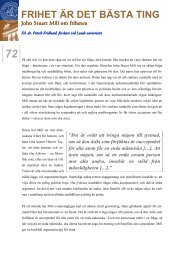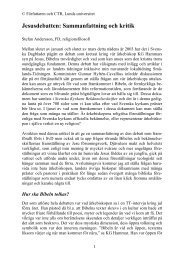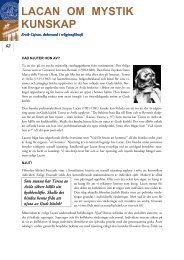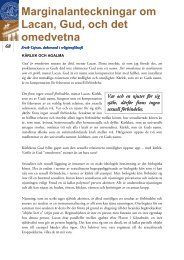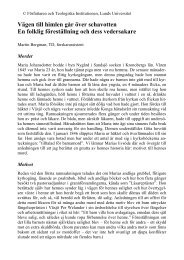Meddelanden 25 (2010) (PDF 2.0 MB - Nytt fönster) - Centrum för ...
Meddelanden 25 (2010) (PDF 2.0 MB - Nytt fönster) - Centrum för ...
Meddelanden 25 (2010) (PDF 2.0 MB - Nytt fönster) - Centrum för ...
You also want an ePaper? Increase the reach of your titles
YUMPU automatically turns print PDFs into web optimized ePapers that Google loves.
further afield; according to the Letter of Ammon, Ammon was steered to the<br />
Pachomians in 351 by his priest in Alexandria, 13 and we know from the vita<br />
tradition that a special house existed for foreign monks. 14 One imagines that<br />
the geographic spread and internal diversity of the federation would result<br />
in multiple dialects within the monasteries and their occasional conflation.<br />
One might likewise explain the varied codex format as a result of the various<br />
codices’ production in different monasteries before their assemblage together<br />
prior to their concealment. It is worth noting in this regard that colophons<br />
in many later codices from the White Monastery’s library indicate<br />
that they came from elsewhere. 15<br />
The contention that the cartonnage either come from a form of monasticism<br />
that had more contact with the world than the Pachomians or from a<br />
non-monastic commercial source can likewise, in my view, be explained as<br />
readily via a Pachomian connection as apart from it. As a village form of monasticism,<br />
contact with the surrounding world was inevitable and, I’d suggest,<br />
expected. The distancing from the world suggested in the literary<br />
sources expresses an ascetic ideal. It is precisely the function of such literature<br />
to encourage the ideal within a world that required the ascetic’s attention.<br />
Life in the world required contact with it. As for the commercial paper,<br />
it is not hard to imagine that Pachomian monks, who operated across such a<br />
wide expanse of Egypt, worked outside of their monasteries, traveled between<br />
them as well as to and from Alexandria, collected scrap paper for use<br />
in book production along the way. Wipszycka argues that the waste paper<br />
trade explains the diverse contents of the cartonnage, but, as Bagnall points<br />
out, she offers no evidence for the existence of such a trade. 16 It seems to me<br />
as easy, if not easier, to imagine monks collecting commercial paper when<br />
available, thus explaining its presence in the cartonnage, than to imagine<br />
how a commercial waste paper trader came into possession of the various<br />
monastic texts in the cartonnage.<br />
Even if, in the end, one grants Khosroyev’s points and imagines that the<br />
Nag Hammadi texts originated in an urban setting where the dialectical con-<br />
13 Epistula Ammonis 2.<br />
14 Bohairic Life of Pachomius 89–91 = First Greek Life of Pachomius 94–95; Armand Veilleux,<br />
Pachomian Koinonia, Vol. 1, The Life of Saint Pachomius and His Disciples (Cistercian Studies<br />
Series 45; Kalamazoo, MI: Cistercian Publications, 1980), 117–23 and 361–62. When<br />
Ammon joined the movement, he was placed in a house with twenty Greek speaking<br />
monks led by the Alexandrian Theodore and his second, Ausonius (Epistula Ammonis 7) .<br />
15 Tito Orlandi, “The Library of the Monastery of Saint Shenute at Atripe,” in Perspectives<br />
on Panopolis: An Egyptian Town from Alexander the Great to the Arab Conquest. Acts from an<br />
International Symposium Held in Leiden on 16, 17, and 18 December 1998 (ed. A. Egberts, B. P.<br />
Muhs, and J. van der Vliet; Leiden: Brill, 2002), 211–31.<br />
16 Wipszycka, “The Nag Hammadi Library and the Monks,” 188; Roger Bagnall, Early<br />
Christian Books in Egypt (Princeton and Oxford: Princeton University Press, 2009), 58.<br />
∙ 65 ∙



